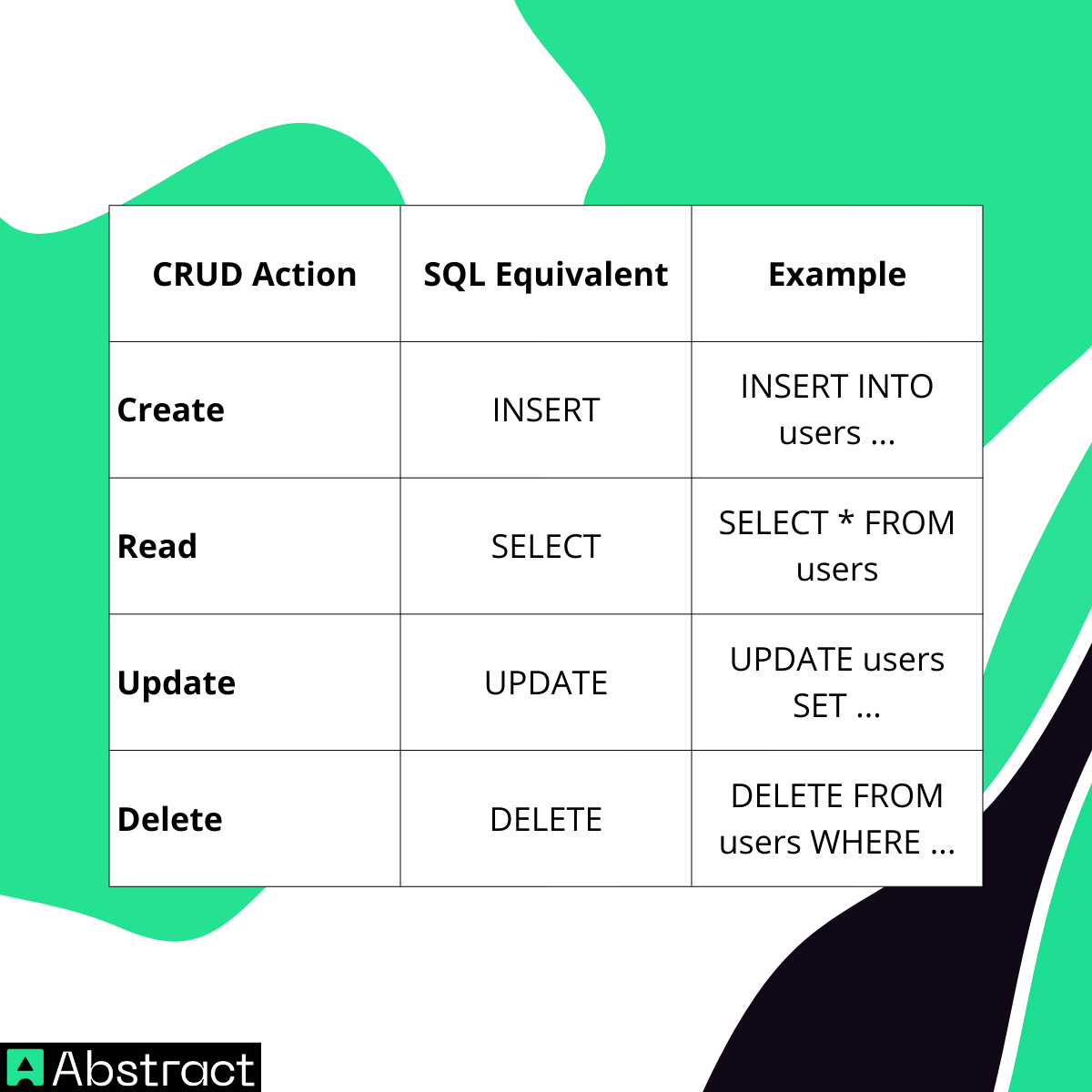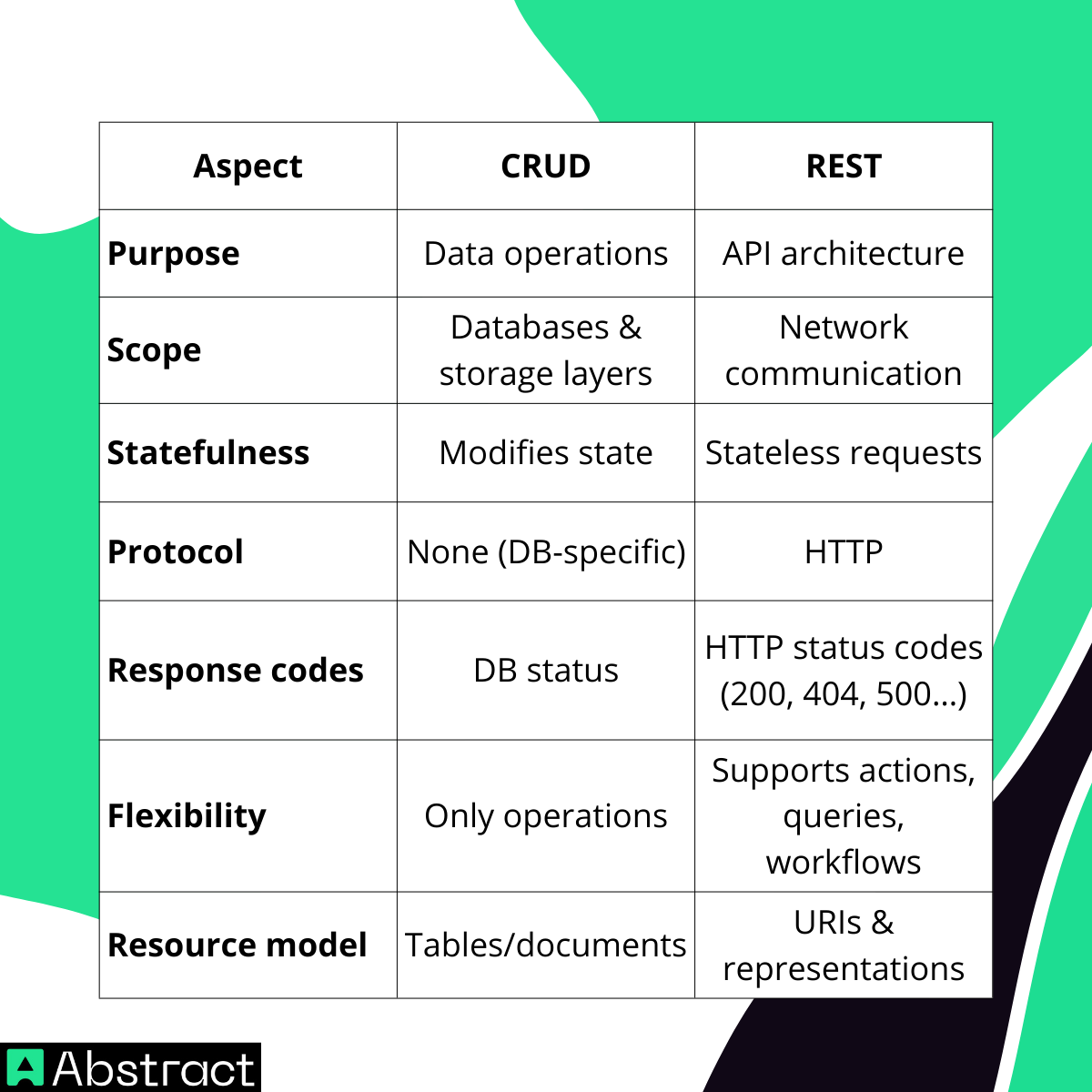Introduction
Because both CRUD and REST work with data, they are frequently conflated — but they are not the same thing.
- CRUD: The basic operations performed on persistent storage (e.g., INSERT, SELECT, UPDATE, DELETE).
- REST: An architectural style used to expose resources over HTTP in a stateless, client–server model.
Why does this matter for developers?
- A strong grasp of CRUD helps you build reliable data layers.
- A solid understanding of REST helps you design flexible, intuitive APIs.
- Most modern APIs rely on REST as their external interface while performing CRUD internally.
👉 In this article, we’ll cover:
- CRUD fundamentals
- REST fundamentals
- Mapping CRUD to HTTP methods
- Core differences
- Real-world examples
- REST in modern architecture
- When to use CRUD patterns vs alternatives like RPC
What Is CRUD? (Create, Read, Update, Delete)
CRUD represents the four essential operations for interacting with persistent data. These operations appear in almost every backend system, regardless of language or database type.
CRUD Operations → SQL Commands

CRUD originated in early relational database theory (1980s–1990s) and is still the foundation of database interaction today. Whether you’re using PostgreSQL, MongoDB, DynamoDB, or a key-value store, the concept persists.
Key Characteristics of CRUD
- It is not an architecture.
- It applies to data storage operations, not API design.
- CRUD is often considered the minimum viable functionality for data-driven applications.
- Many developer tools, admin dashboards, and ORMs are entirely CRUD-based.
What Is REST? (Representational State Transfer)
REST is an architectural style for building web services. It defines how clients and servers should communicate using HTTP in a stateless way.
Core REST Constraints
REST has several defining principles:
- Client–server separation
- Statelessness: Each request is independent
- Cacheability
- Uniform interface: Standardized methods, URIs, and representations
- Layered system
Most REST APIs expose resources using HTTP verbs, such as:
- GET
- POST
- PUT
- DELETE
- PATCH
REST in 2025
REST remains the most widely adopted API style due to its:
- Simplicity
- Backward compatibility
- Predictability
- Strong fit for CRUD-like interactions
REST also coexists with GraphQL, gRPC, and event-driven APIs, but continues to provide the most stable way to expose CRUD functionality across distributed systems.
👉 Want to learn more about REST basics? See AbstractAPI’s guides:
CRUD vs REST: Mapping & Overlap
While CRUD describes operations, REST describes communication patterns. However, REST endpoints often correspond directly to CRUD actions.
CRUD → REST HTTP Method Mapping

Example: RESTful CRUD for /users
# Create
POST /users
Body: { "name": "Ana", "email": "ana@example.com" }
# Read
GET /users/12
# Update
PATCH /users/12
Body: { "name": "Ana María" }
# Delete
DELETE /users/12
Key Differences Between CRUD and REST

Additional Distinctions
- A CRUD system is not automatically RESTful.
- A REST API does not need to be limited to CRUD actions.
- REST can trigger processes, workflows, and actions — not just data operations.
Example non-CRUD REST action: POST /users/12/reset-password
This triggers a workflow rather than updating a row.
Example Scenario: A Simple Blog API
Let’s compare how CRUD and REST view the same task.
CRUD Perspective (Database Layer)
- Create a post → SQL INSERT
- Read posts → SELECT * FROM posts
- Update a post → UPDATE posts SET ...
- Delete a post → DELETE FROM posts WHERE id = ...
REST Perspective (API Layer)

Sample Express.js REST Route
app.post("/posts", async (req, res) => {
const { title, body } = req.body;
const newPost = await db.posts.insert({ title, body });
res.status(201).json(newPost);
});
Notice:
- The API handles HTTP…
- …and then calls CRUD operations on the database.
This demonstrates how REST sits above CRUD in the application stack.
Advanced Topics & Modern Context
✔ REST Is Not Limited to CRUD
REST endpoints can perform actions, run jobs, or trigger automations.
Examples:
- POST /servers/33/reboot
- POST /orders/123/process
✔ SCRUD and CRUDL
Common CRUD extensions:
- LIST → GET /users
- SEARCH → GET /users?name=ana
✔ REST in Microservices
In distributed systems:
- REST acts as the stable boundary between services.
- Internally, services perform CRUD or write events.
- REST ensures consistent, predictable external interfaces.
✔ When NOT to Use REST
If your operations are commands rather than resource manipulation, RPC may be better.
Examples:
- processPayment
- calculateRoute
- validateDocument
Related AbstractAPI Resources
Conclusion
CRUD and REST are related but fundamentally different concepts:
- CRUD defines what operations you perform on data.
- REST defines how clients and servers communicate over HTTP.
A high-quality REST API will usually implement CRUD operations — but that doesn’t make REST and CRUD equivalent.
Understanding where each applies helps developers design cleaner, more scalable systems and choose the right pattern for the right problem.



